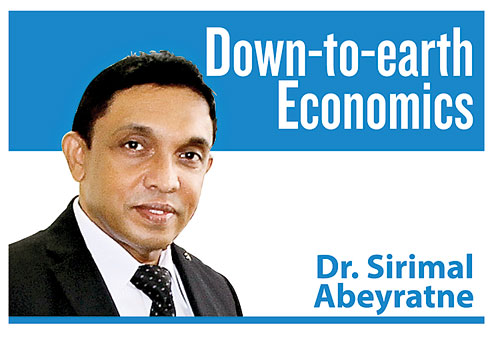With or without IMF…
View(s):Whether Sri Lanka should seek IMF assistance or not! This has been a major question which has baffled the government within as well as outside. It has been a “temporary question” anyway, because the time is coming for keeping all disputes aside, no matter how painful it would be particularly for those with vested interests.
However, it is not the main question that Sri Lanka must worry about right now. Before we turn to the main question at hand, let me elaborate the background, which is interesting. 
Over the past two years, the IMF has committed to providing US$250 billion financial assistance to its COVID-affected and debt-ridden member countries. This amount is equivalent to a quarter of the IMF’s one-trillion-dollar total lending capacity. And, of course, Sri Lanka didn’t want it.
We need billions
Out of the 190 IMF-member countries, 90 countries have received this IMF financial assistance. Among the South Asian countries, Bangladesh has obtained $732 million, Maldives $29 million, and Nepal $610 million. Unlike other South Asian countries, however, Sri Lanka’s annual debt service payments cannot be sorted out in dollar millions, but billions!
By the way, a few weeks ago the Nepal government has also approved the US-funded MCC grant of $500 million. Sri Lanka was also entitled to receive the MCC grant of $480 million, but it was also rejected by the government in February 2020.
If Sri Lanka should seek the IMF assistance, in fact, it should have done so as early as possible, perhaps at least at the early stages of the COVID-19 pandemic in 2020; there are at least two reasons for this claim:
1. With IMF assistance as early as possible, Sri Lanka would have been under a reform programme to restore its worsening macroeconomic stability – government’s budgetary prudence, monetary discipline without getting the Central Bank to fund government spending, strengthening foreign exchange reserve position, and improving debt sustainability.
2. Sri Lanka would have avoided or at least mitigated much of its negative economic outlook that has resulted in a “bad international image” of the country. While major international media platforms have already painted the country’s unprecedented economic and humanitarian crisis, the international credit rating agencies continuously downgraded the “credit worthiness” of the country over the past two years.
Anyway, it’s already gone, and we missed the bus. And today, here we are with unsustainable debt service payments bunching up every year. Apart from that the public is battered by supply shortages in basic needs and skyrocketing prices as well as the loss of incomes and work.
Fortunes out of debt
In such situations, not only borrowings, but anything related to debt-sustainability issues – all are opportunities which would bring about fortunes to somebody. International bond markets provide lucrative business opportunities to bureaucrats, brokers, underwriters, local and international; of course, at the expense of tax-payers, if the borrower is a government.
These international bond markets carry lending and borrowing in really big amounts – as big as US$ billions. Even half a billion-dollar borrowing, which may be the “minimum” that a country can request is too small. Therefore, it’s a market for big players so that even those who get involved in any type of business should also be paid high sums! The famous international bonds, issued by rich countries, have also got colourful names for their bonds such as Yankee bonds of the US, Samurai bonds of Japan, Rembrandt bonds of the Netherlands, Panda bond of China and Bulldog bonds of the UK.
It is risky for a poor country to enter these, as you are going to play the game as per the rules of the rich! When the debt service payment cannot be met, the country can also send the politicians and bureaucrats around the world seeking financial assistance. If not, the country can also go for “debt restructuring” which is another opportunity to hire consultants and send them around the world to negotiate with the lenders. They all should be paid well too, while taking care of their travel, accommodation and, incidental expenses.
When the borrowing country is not in a good financial position, as depicted by the down-graded credit rating, bond prices would go down in the secondary market! This is an opportunity to buy at low price and return to the issuer at the face value; if you are sure that the bond issuance will not default your bonds but will pay you even by borrowing from someone else, it is an opportunity not to miss out!

File picture of the Colombo stock market which has crashed this week due to the economic crisis.
IMF assistance?
Sri Lanka entered the international bond market in 2007 and borrowed $17.5 billion in total by 2019; it now accounts for 47 per cent of the country’s total foreign borrowings. So far, Sri Lanka’s foreign borrowings were limited largely to multilateral and bilateral borrowings, which were mostly tied up in designated projects. Until 2010, Sri Lanka’s annual foreign debt service payments were around $1 billion a year, which has now shot up to $5-6 billion.
Should we seek the IMF assistance? Some would argue that the IMF assistance will come with conditions! Some would go even further arguing that Sri Lanka has resorted to IMF assistance 16 times before, but it has all been futile; obviously, it shows that there is a problem at the recipient’s side. Or should we continue to go around seeking more borrowings from other countries, as we have been doing so far?
However, neither of them gives an answer to Sri Lanka’s debt crisis, and its related economic mess! They would rather postpone the problem which would come back multiplied, sooner or later.
The main question is, therefore, “what have we done over the past 24 months?” in addressing the underlying causes of the problem. It’s all about improving the government’s budgetary position, eliminating losses and wastage, restoring monetary discipline, and improving external finance position including export growth.
In fact, the Staff Report of the IMF’s Article IV Consultation released last month also highlights some of these policy options. What it doesn’t pay much attention is to emphasise the necessary policy reforms to accelerate export growth and FDI inflows.
The government’s tax revenue base should be widened, wasteful and unproductive expenditure should be eliminated, and targeted social safety net system must be established. After many decades of implementation, there is no need of further evidence to understand the failure of the public enterprises such as the Electricity Board or the Petroleum Corporation or any other, which have ultimately failed to fulfil their expected service to the public; they all require reforms. At least now, we must understand that there are plenty of electricity, gas and fuel suppliers in the world, who can meet the local demand under competitive conditions without daily shortages.
Piecemeal-type
The Department of Census identifies about 200,000 households of the country as “poor”, but there are over 1.5 million households who receive “Samurdhi” benefits; and after all, it is a question one must ask as to how many families have been raised up from poverty through the implementation of the “Samurdhi” as a “poverty alleviation” programme for over four decades. Shouldn’t it be a targeted poverty alleviation programme, through which the poor actually rise up from poverty?
While fiscal consolidation is to be accompanied by monetary discipline as well, long-term policy reforms need to be undertaken in order to improve the economic status of the country and to establish debt sustainability. This requires ensuring long-term economic growth, which have been subdued by critical policy errors in the last two years as well.
The fertiliser policy has reduced agriculture production and productivity, while increasing rural poverty. Electricity, gas and fuel shortages and import controls, all have played their critical role in plummeting domestic production and exports of the country as well as income and employment of the people. Finally, right at this juncture, the economy needs an overall reform package and, not a piecemeal one.
(The writer is a Professor of Economics at the University of Colombo and can be reached at sirimal@econ.cmb.ac.lk and follow on Twitter @SirimalAshoka).
Hitad.lk has you covered with quality used or brand new cars for sale that are budget friendly yet reliable! Now is the time to sell your old ride for something more attractive to today's modern automotive market demands. Browse through our selection of affordable options now on Hitad.lk before deciding on what will work best for you!


